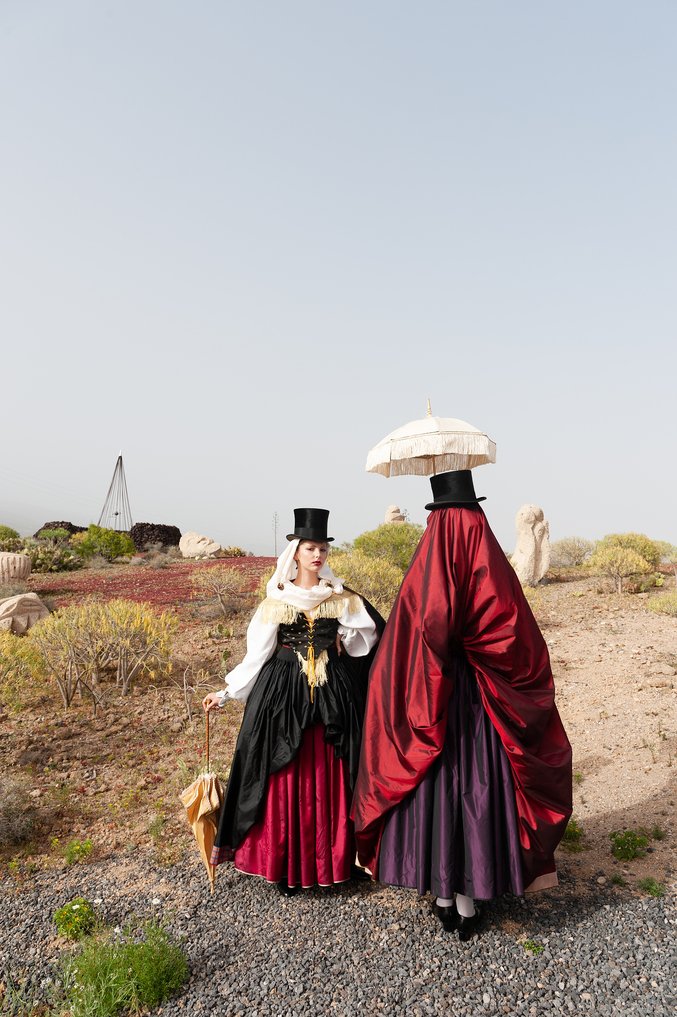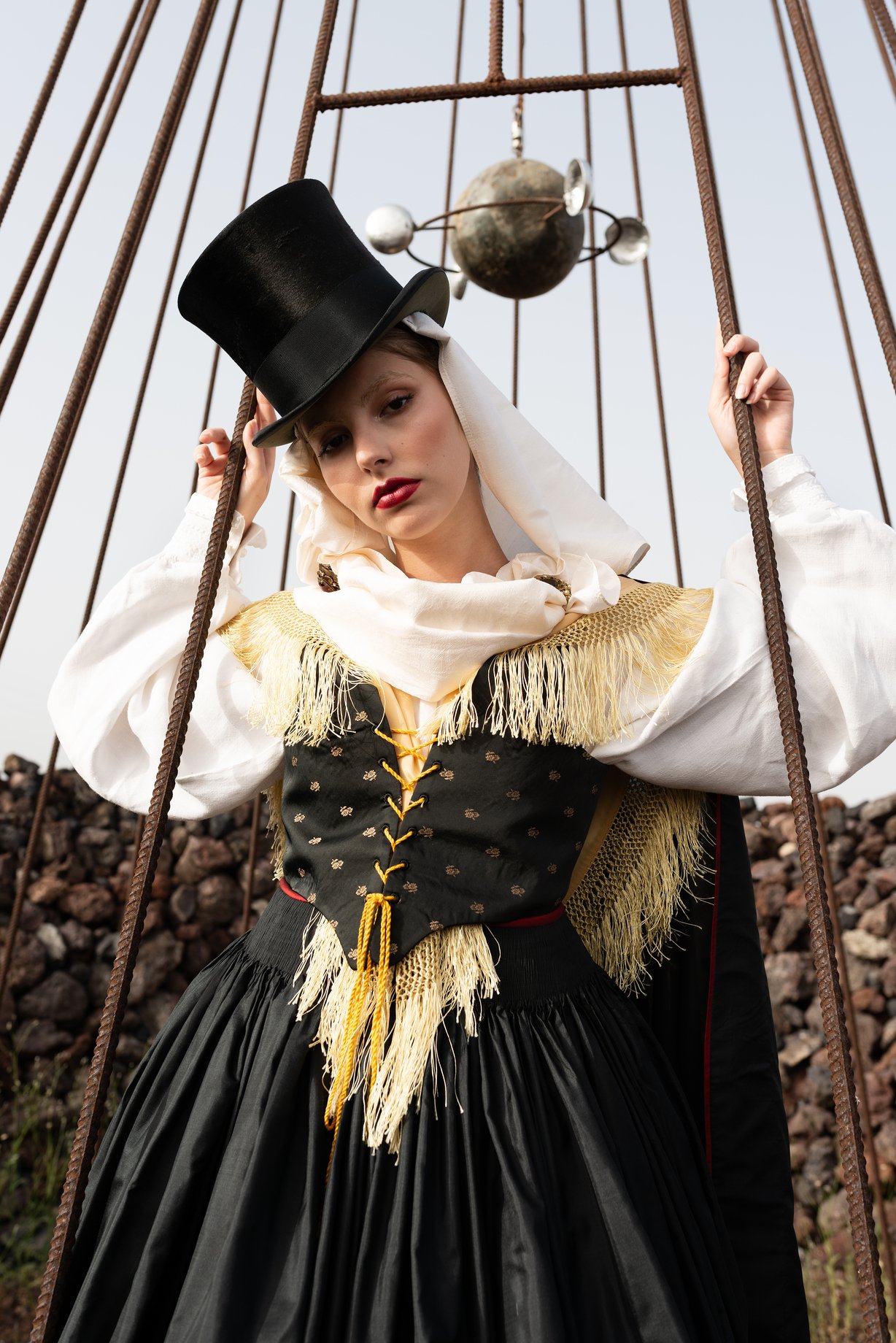Meet the Spanish collector José Ramón Velasco Alonso
Imagine that you open a cabinet in a museum of traditional clothing. You take a dress out, and observe how her stiffness is softened by the fresh air. She woke up from a long sleep, so give her a little more time and let her speak.
This is the story of the forgotten ritual of dressing up in the 19th century, retold at La Palma, the most Northwestern of the Canary Islands.
When a lady got dressed it looked like a process of creating a sculpture. Ten to fifteen components of the costume were shaped on her body for at least ten minutes. She put on her clothes with the help of two people, in a particular order, including: a blouse, skirts, petticoats, jerkins, bodices, stockings, hats, headdresses, umbrella, jewellery, shoes, and more. She was dressed in layer upon layer like a blooming flower. This painstaking creation of the ideal female figure embodied the idea of clothing as an art.
Under the guidance of the Canarian collector José Ramón Velasco Alonso, we, as a group of artists and friends, recreated this powerful ritual in one of the most unconventional sculpture parks in Canary Islands: “El Parque de Esculturas de Los Cardones” run by Gisela and Gernot Huber. José has been collecting 19th century Canarian costumes since 1995. After many years of studying, he began to manufacture the garments as faithful as possible to historical documentation.
Nature was one of the artists who determined the richness of the traditional costumes with various microclimates shaping clothing designs. Surrounded by sculptures on a remote volcanic hill among palm trees and cactuses, we let the dresses speak their message:
“Just like the Japanese tea ceremony changes the experience of drinking tea, I change people’s experience of their clothing. The intrinsic and cultural value of the act of dressing allows people to rediscover the power of garments as an expression of sustainable fashion.”
Interview with José Ramón Velasco Alonso
When did you start collecting traditional costumes?
I started collecting traditional clothing in 1995/1996. I always had an interest in clothing, so I gradually learned about garments and their preparation. With this knowledge, I began to manufacture garments myself. For years, I have worked on collecting fabrics (silks, taffeta, brocades, etc.) that have become a part of my collection.
How big is your collection?
It is a fairly extensive collection, encompassing the three types of women’s clothing that are collected on the island of La Palma (work suits, gala dresses, and mantle and skirt suits. Likewise, I have also tried to collect a smaller representation of men's clothing.
Why are traditional designs important to you?
Clothing in general brings us to the past because our current fashion is the result of what has happened in history. In order to understand today's preferences, we have to understand the past. We constantly observe old trends that are making a comeback. Behind those pieces of clothing are certain memories, sentiments, and emotions. I like to know what shaped our reality, that is why learning about traditional clothing is so interesting. I’m interested in all types of costumes - particularly peasant clothing, as well as others made with richer fabrics.
If you could describe traditional clothing from La Palma in 3 words, what would they be?
I only need two words: elegant and sober.
What is the meaning of La Palma’s costume designs and colors?
Traditional costumes from La Palma had a very clean and plain aesthetic. We didn’t use many patterns. The small embroideries that appeared on the petticoat under the skirt were inspired by nature.
The colors were those that could be obtained from natural dyes. Likewise, the fabrics (wool, silks, linens) were made by the artisans of the time and dyed with artisanal techniques using natural products (onion peel, almond shells, cochineal), etc. The color base of the time ranged from black, brown, and blue, both in wool and silk fabrics. In the case of silk, the range of garnet, cherry, and magenta colors was also used.
Are there any stories or myths about traditional costumes from the Canary Islands?
When it comes to traditional clothing there is no absolute truth. There are too many unconfirmed stories and only a few real "witnesses" that can serve collectors as guidance in order to reproduce clothes. In the vast majority of cases, we have to limit ourselves to the written and painted documentation that is preserved and which, luckily, is edited and preserved with great care. In my work, it is important to stick to reliable sources and disconnect from myths.
Which festivals in the Canary Islands are associated with wearing traditional clothes?
The usage of traditional clothing, in general, is the expression of people trying to reproduce customs of the old times. By wearing these costumes on special occasions, we cultivate our history and crafts. We usually do it during cultural manifestations such as romerías (pilgrimages), folklore events, Romera elections, and Taifa dances (Baile de Taifas), in which the attendees dress in different types of clothing demonstrating the cultural heritage of our islands.
The Art of Dressing Up
Welcome to the world of the forgotten ritual of dressing up, which leads us through different stories. Our project honors the traditional costumes of La Palma, which are divided into three different styles: the Manto y Saya, Traje de Gala, and Traje de Faena.
Clothing: Manto y Saya
Mantle and skirt suits, called “Manto y Saya” were the most elegant costumes in La Palma and they were associated with wealthy urbanites and the nobility. They were designed with high quality materials like silk or wool. The beautiful lace umbrellas not only made the Manto y Saya more theatrical and sublime, they also protected against the intense sunlight of the Canary Islands.
Clothing: Manto y Saya
The name of this costume comes from its unique shape, including the two skirts for which it is named. The “Saya” was a conventional skirt which flowed from the waist to the ankles. The silk “Manto”, on the other hand, was gathered up along the back and worn around the head, resembling a cloak; this was often dyed with colours that contrasted beautifully with a black top hat. The Manto is a particularly unique garment of La Palma, and it was invented for special occasions, Sundays, or church ceremonies. When a woman walked wearing the Manto y Saya, the appearance of the back of the dress changed, creating an endless kaleidoscope of shapes.
Clothing: Manto y Saya
The Women of La Palma also wore silk gauze to wrap their faces. It was often opened and decorated with brooches. The Manto y Saya was accompanied by accessories such as reliquary pendants, pearl strings, necklaces, earrings, bracelets, buckles for shoes, and rosaries. These were often heirlooms handed down from mother to daughter across countless generations. Every detail of the costume was carefully planned for aesthetic appeal.
Clothing: Traje de Gala
The Traje de Gala, literally meaning “gala costume”, was made of silk and refined fabrics, and rather than multiple skirts, it consisted of a large number of layered cotton, linen, and silk petticoats. It was also enriched with embroidery, mainly on the petticoats and blouse. Particular attention was paid to the placement of garments’ elements and accessories to achieve a glamorous look which significantly improved the appearance. Unlike work clothes, the gala costumes had no apron or montera headdress, and lacked the side gathering of the first petticoat typical for other outfits. Instead they had elegant and coquettishly arranged chiffon veils adorned with ornaments.
With time, the older, heavier petticoats were replaced by softer, lighter ones which allowed women to layer several petticoats upon each other to emphasize and expand upon their feminine figures. According to oral tradition, women could wear up to eight petticoats on special occasions.
Clothing: Traje de Gala
The perfect proportions of the body were obtained thanks to the bodice which was an essential garment in all forms of Palmeran clothing, unless the doublet was worn. In the 19th century, bodices became less rigid and included torso adjusters. They were commonly made with imported fabrics like silk, with linings of linen or cotton. These bodices functioned as an external bra, and were decorated with abundant eyelets and a cord to outline the torso. This is how the beautiful V-shape made the waist small and perfectly composed with the line of the shoulders and hips.
Clothing: Traje de Gala
The textiles of the Traje de Gala were colored with natural vegetable dyes and natural products farmed on the island such as saffron, almond shell, walnut, eucalyptus, etc. The gala costume was topped off with a small brimmed hat, made of palm or rye straw, and adorned with feathers, ribbons and flowers.
Clothing: Traje de Faena - The Town of Puntallana
The pronounced, lateral gathering of the skirt was characteristic of the working costume, and prevented the skirt from dragging through dirt. Under the skirt women wore petticoats which were mandatory in all forms of clothing. The petticoat of a working costume could be decorated with black woolen embroidery with subtle motifs of broken lines, triangles, rhombuses, spirals, flowers, etc. These exuded inspiration from notable Islamic art. La Palma has a long tradition of embroidery, which was passed from generation to generation. Thus, these are some of the most precious traditional inheritances of the island.
Clothing: Traje de Faena - The Municipality of Garafía
The type of headdress worn with typical everyday clothes was called la montera. There were a few types of las monteras, and the common type looked like the hull of an upside-down boat. They covered the entire diameter of the head, fitting firmly upon the gauze scarves without any type of fastening. La monteras, like other hats, covered the heads and protected women from the cold, strong wind, and the sun. Women of La Palma often carried one or two needles and thread attached to their headdress to be prepared to repair their costumes of unexpected damage. Obviously it was carefully hidden and invisible to others.
Clothing: Traje de Faena
The adaptation of the clothing to the climate, daily activities, and readily available materials have marked the dressing of La Palma. The most practical costume for everyday use, the Traje de Faena, consisted of the following garments: petticoats, a linen blouse, a durable wool skirt, a bodice, an apron, a wool hat, and a gauze scarf. Women dressed similarly throughout the year, adding or removing particular elements of the clothing depending on the weather conditions. Rural everyday clothing was adapted to the hot and arid climate of the islands, hence the literal meaning of Traje de Faena - work clothes. The overlapping skirts and petticoats provide warmth in the cold mornings, yet their lightweight and breathable fabrics relieve the intense afternoon heat. Here, the silk bodice of the gala costume was replaced by coarse, and thick fabrics woven from the family’s looms, such as brocade, jacquard, wool, linen or even hemp. La Palma has a long tradition of textile work, using both looms and needles, earning the locals their well-deserved fame in the art of clothing. The weather and natural resources favoured the island’s production of silk, linen, and wool.
The team:
Photographer and creative director: Lucilla Bellini
Model and creative director: Gabriela Barnat
Model and make-up artist: Dafne Palles González
Copywriting: Gabriela Barnat










